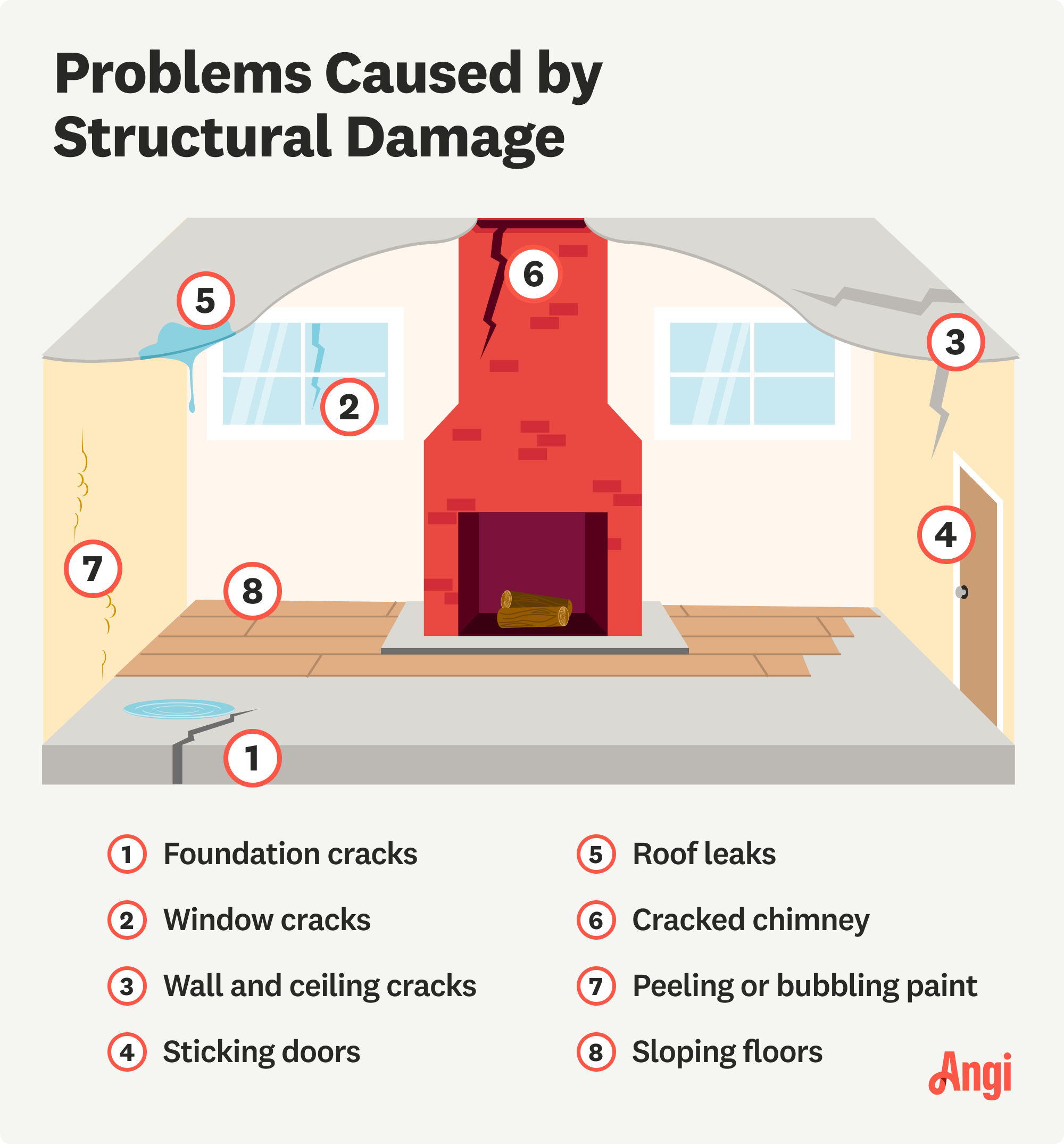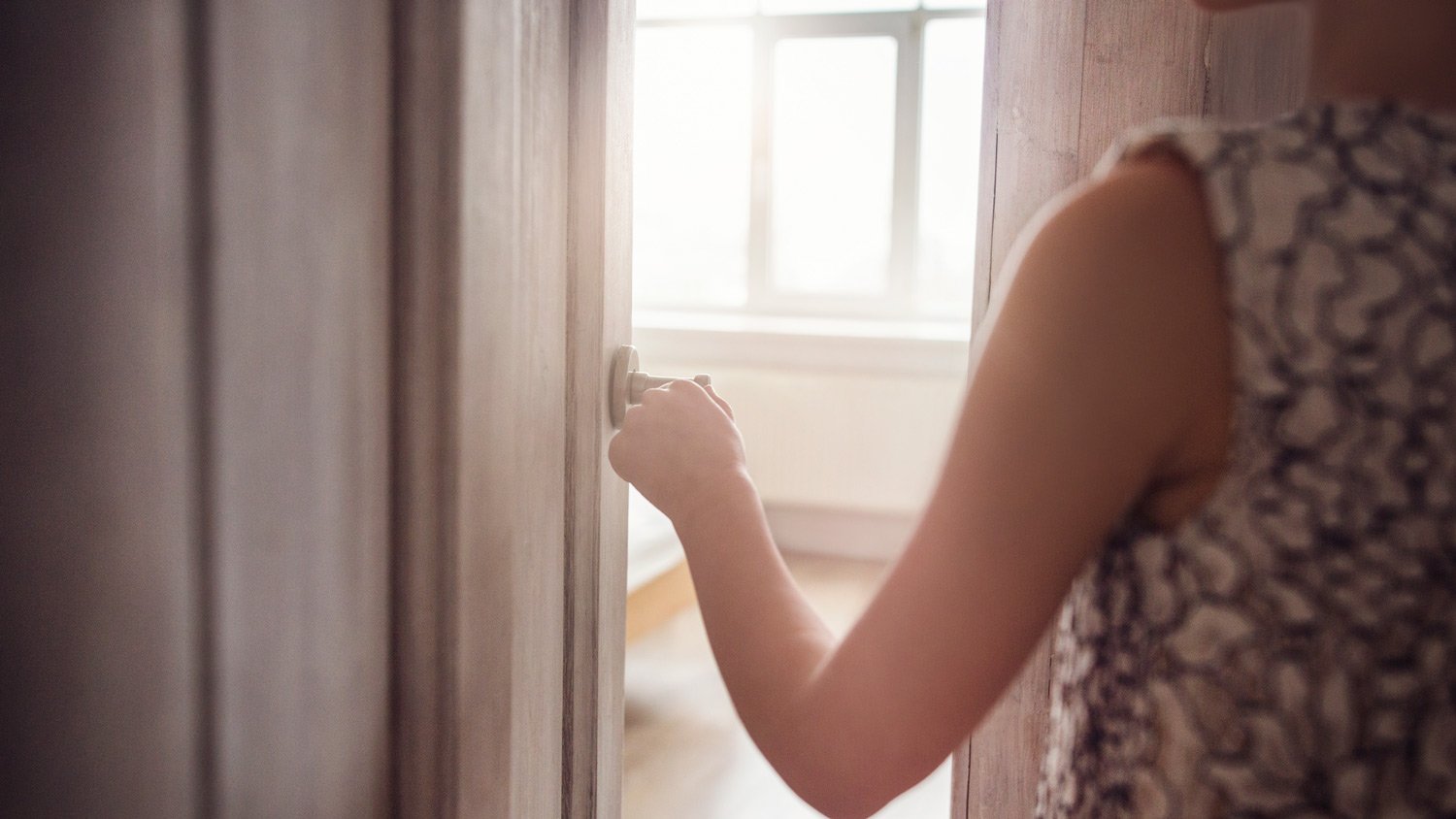10 Signs of Structural Damage in Your Home
Don’t ignore these red flags when it comes to your home


Structural damage often causes small changes in your home such as sticking doors and windows, peeling paint, and bouncy floors.
Cracks are one of the most common signs of structural damage, which may appear in the foundation, chimney, walls, ceilings, or windows.
You should hire a structural engineer to assess your home and make recommendations.
Your home is your refuge and your biggest investment, so keeping it in good shape is a high priority. Some problems, however, indicate that more than regular maintenance might be needed in order to keep your home structurally sound. Learn to recognize the signs of structural damage that indicate you may have a serious issue you need to address.
Why Is Structural Damage Dangerous?
Any damage to your home’s structure can lead to safety risks. Problems with the foundation, roof, floors, or walls can affect the stability of your home, leading to more extensive damage.
Structural damage is also expensive to repair, especially if problems compound. Lastly, structural damage can affect your home’s value, making it more difficult to sell, as well as making it harder to insure.
Some warning signs of structural damage in your home include curving interior walls, horizontal cracks in the foundation, and sagging floors or roofs. Calling in a structural engineer to take a look as soon as you notice these signs can save you from a bigger problem later on.
Signs of Structural Damage

Knowing what to look for when it comes to structural damage can help you save on the cost of expensive repairs and the headache that goes along with them. Catching structural damage early is always the best bet—problems will only get worse, more dangerous, and more expensive to fix as time goes on.
1. Foundation Cracks
Your home’s foundation is a critical component of the building’s stability, and foundation issues can often lead to large, costly repairs. Foundation cracks are one of the most common signs of structural damage, but not all cracks indicate serious problems or are a sign that your house will collapse.
As a house settles, it’s not unusual for foundations to develop small cracks, but larger cracks, horizontal cracks, or cracks that allow water to enter the foundation should all be taken seriously. A home inspection from a structural engineer can help you determine whether a foundation crack indicates a problem that needs to be fixed.
2. Wall and Ceiling Cracks
Visible cracks in your drywall can be a red flag that something is structurally amiss. Small hairline cracks are often nothing to worry about, but larger cracks, cracks that are growing in size, and cracks that spread from ceilings to walls or vice versa can signal that the pressure being exerted in that area has changed.
3. Window Cracks
A cracked window is not always a sign of structural damage, as window glass is fragile and can crack for any number of reasons, like impact damage or extreme temperature changes. In some cases, though, a cracked window may be a sign that you should check if your home has structural issues that need to be addressed. Investigate further if:
The crack is in a basement window
The crack runs horizontally across the window
Replacement windows crack in the same way the original window did
4. Sticking Windows and Doors

Issues with windows and doors, particularly sticking when you open and close them, can be an indication that something is structurally amiss in your home. Windows and doors often stick due to humidity, but if a previously functioning window or door is suddenly difficult to open or close, it’s worth following up on, as it may indicate cracks in the wall or uneven floors.
5. Bouncy Floors
Your home’s floors should feel solid and supportive as you walk across them. Floors that feel spongy or bouncy can be a red flag that something is wrong underneath them. A bouncy or squeaky floor may indicate joist problems, damaged subflooring, or foundation issues. Any changes to how your flooring feels should be looked into in case they’re the result of structural damage.
6. Sloping Floors
Formerly level floors that are sloping can be a sign of a dramatic foundation shift or damaged joists or subfloor. Floors that are no longer level should be investigated to see if the issue is normal house settling, improperly installed flooring, or something more serious.
7. Roof Leaks
A leaky roof can not only cause serious water damage to your home, but it may be an indication of a larger structural problem. Roofs can leak for a number of reasons, including shifting of your home’s frame, damage from weather, or lack of maintenance. Always look into roof leaks as soon as you’re aware of them in order to protect your home from further damage.
8. Crumbling Concrete
Crumbling concrete often occurs due to water intrusion, so if you notice your foundation is crumbling in spots, it may be a clear sign that you have a water problem. In addition to crumbling concrete, you may also notice signs of water damage in your basement from water coming through the foundation. You may be able to remedy the issue by sealing or re-sealing the foundation, but any problems that affect your foundation involving water should be taken seriously.
9. Cracked or Crooked Chimney
Chimneys can also show signs of structural damage if you know what to look for. Cracks in the chimney, or a chimney that no longer sits level, can be a clear sign that your foundation is shifting and pressure is being placed on the chimney, causing damage.
10. Peeling or Bubbling Paint
Suddenly finding flaws in your paint can let you know that something is happening in or behind your walls. Changes to paint can be caused by water problems, such as a plumbing leak behind the wall, moisture intrusion from a roof leak, or termite activity that creates moisture within the nest. All of these issues can cause serious and costly damage to your home, so always look for the source of paint problems.
How to Know You Need to Hire a Pro for Structural Damage
If you notice any of the above signs of structural damage, you want to hire a structural engineer to investigate the problem and determine whether or not your issue needs to be fixed. The cost of a structural engineer is well worth it, as structural damage can be extremely serious and expensive to fix, and it’s always better to remedy a problem as early as possible before it has a chance to get worse.
A local structural engineer can assess the extent of the problem and make recommendations about the best way to proceed in order to protect your investment and keep your home safe for everyone.
Can You DIY Structural Repairs?
Repairing structural damage is a job best handled by professionals. Major structural repairs require equipment and expertise that the average homeowner just doesn’t have. There may also be a legal component. Some kinds of repairs require a licensed professional to pull permits, do the work, and meet local building codes.
How to Prevent Structural Damage From Occurring
Preventing structural damage requires regular proactive maintenance and staying aware of any changes to your home. Some ways to prevent structural damage include:
Have an annual roof inspection to check for damage.
Monitor your basement and crawl space for cracks or signs of water damage.
Inspect your foundation once a year to identify potential problems.
Repair any water leaks or plumbing problems as soon as you notice them.
How Much Does It Cost to Repair Structural Damage?
The cost of repairing structural damage depends on the type of damage and how extensive it is. The cost of foundation repair can range from as little as $250 to fix small cracks up to $20,000 to lift the foundation. Repairing your roof can cost between $150 and $8,000 on average. The average cost of repairing water damage ranges from $1,350 and $6,250, depending on the extent of the damage and which materials need to be replaced.
Frequently Asked Questions
Structural damage can be repaired, but it’s best to hire a licensed professional to ensure the job is done right. Major structural repairs require specialized equipment and training, and you want to know that your foundation, roof, floors, or walls have been properly repaired so they’re in good condition for years to come.
The longer structural damage goes unfixed, the worse the problem will get. You should repair any structural damage as quickly as possible to prevent the problem from getting more severe and avoid any related damage that may occur over time.
You can sell a house with structural issues, but you’ll need to disclose the problems and it will affect the selling price. Buyers purchasing houses with structural issues may have trouble obtaining financing or insurance, so it may be more difficult to sell your home if it has structural damage.





- 11 Warning Signs of Foundation Issues
- Foundation Cracks: What’s Normal and When to Worry
- What a Foundation Inspection Is and How to Check Yours
- When to Worry About Cracks in Your Basement Floor
- 15 Warning Signs That a House Will Collapse
- 10 Types of Drywall Cracks and What They Could Mean
- How to Fix Foundation Cracks: Your Guide to Identifying and Repairing Cracks by Type
- 10 Reasons You Really Shouldn't Delay Foundation Repairs
- How Long Does Foundation Repair Take?
- What to Do After Water Damage in Your House and Why Act Fast
















